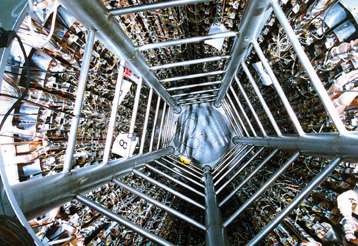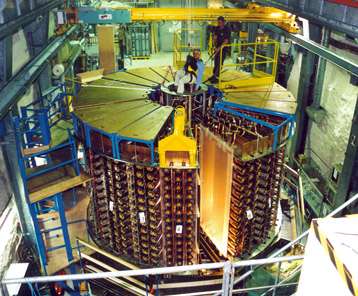NEMO closes in on neutrino mass

The NEMO (Neutrino Ettore Majorana Observatory) experiment, whose goal was to elucidate the nature of neutrinos and measure their mass, yielded very positive results. The product of an extensive international collaboration including seven CNRS joint laboratories1, the detector, installed in the Modane Underground Laboratory (CNRS/CEA) in the Fréjus road tunnel, ran from 2003 to 2011. The observation, in seven different isotopes, of an extremely rare radioactive decay event, the so-called 'allowed' double-beta decay, helped improve our understanding of the atomic nucleus. In addition, the data collected during the search for the so-called 'forbidden' double-beta decay enabled the researchers to establish a range (0.3-0.9 eV) for the upper limit on the mass of the neutrino.
These findings, just published in the journal Physical Review Letters shed new light on neutrino physics and cosmological models. The technology chosen for NEMO opens the way for the SuperNEMO detector, which will be 100 times as sensitive and may even be able to detect so-called 'forbidden' double-beta decay, which would usher in a new era in physics.
The NEMO detector was aimed at observing an extremely rare radioactive phenomenon, double-beta decay, which only occurs in a few isotopes with half-lives as long as 100 billion times the age of the Universe. In 'allowed' double-beta decay, two neutrons are simultaneously converted into two protons, and two electrons and two neutrinos are emitted. During its eight years of operation, NEMO detected a million such events in seven different isotopes, thus helping to elucidate the structure of the atomic nucleus.
Some theories predict the existence of a double decay with no emission of neutrinos. This decay is said to be 'forbidden', since it violates the Standard Model on which the whole of particle physics is based. If such decay actually exists it would mean that the neutrino is a so-called Majorana particle, in other words, a particle that is its own antiparticle. According to cosmologists, this could explain why matter was created in the early Universe and why it prevailed over antimatter. NEMO was unable to detect neutrinoless double-beta decay. However, the data collected enabled the researchers to establish that the upper limit on the mass of the neutrino must be in the range 0.3-0.9 eV, depending on the nuclear model considered. It also allowed them to set the most accurate limits to date for certain neutrinoless double-beta decay modes, in particular that involving supersymmetric particles.
The main goal of the NEMO experiment was to detect an extremely rare signal, double-beta decay, which is normally hidden by stray radiation and natural radioactivity. To protect it from this background radiation, the NEMO-3 detector was set up under around 2,000 m of rock, in the Fréjus road tunnel, and built using materials with very low radioactivity. As a result, total radioactivity levels inside the dectector are 10 million times weaker than natural radioactivity.

Another characteristic that makes the NEMO instrument unique is its ability to identify the particles emitted in double-beta decay while at the same time using calorimeters to measure their energy. The quality of the data obtained thanks to these technologies opens the way for SuperNEMO, a detector that will be 100 times as sensitive and may be able to detect neutrinoless double-beta decay. With this future instrument, expected to be up and running in 2018, the scientists hope to usher in a new physics that goes beyond the Standard Model.
More information: "Search for Neutrinoless Double-Beta Decay of 100Mo with the NEMO-3 Detector" ; R. Arnold, C. Augier, et al. Physical Review Letters ; 12 June 2014. arxiv.org/abs/1311.5695
Journal information: Physical Review Letters
Provided by CNRS





















